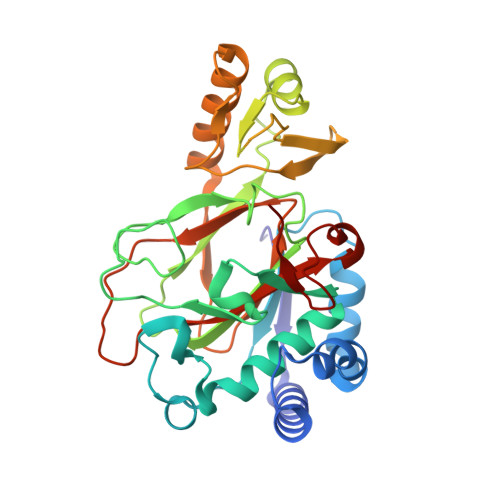alpha-Amine Desaturation of d-Arginine by the Iron(II)- and 2-(Oxo)glutarate-Dependent l-Arginine 3-Hydroxylase, VioC.
Dunham, N.P., Mitchell, A.J., Del Rio Pantoja, J.M., Krebs, C., Bollinger Jr., J.M., Boal, A.K.(2018) Biochemistry 57: 6479-6488
- PubMed: 30403469
- DOI: https://doi.org/10.1021/acs.biochem.8b00901
- Primary Citation of Related Structures:
6MP8, 6MP9 - PubMed Abstract:
When challenged with substrate analogues, iron(II)- and 2-(oxo)glutarate-dependent (Fe/2OG) oxygenases can promote transformations different from those they enact upon their native substrates. We show here that the Fe/2OG enzyme, VioC, which is natively an l-arginine 3-hydroxylase, catalyzes an efficient oxidative deamination of its substrate enantiomer, d-Arg. The reactant complex with d-Arg retains all interactions between enzyme and substrate functional groups, but the required structural adjustments and opposite configuration of C2 position this carbon more optimally than C3 to donate hydrogen (H • ) to the ferryl intermediate. The simplest possible mechanism, C2 hydroxylation followed by elimination of ammonia, is inconsistent with the demonstrated solvent origin of the ketone oxygen in the product. Rather, the reaction proceeds via a hydrolytically labile C2-iminium intermediate, demonstrated by its reductive trapping in solution with NaB 2 H 4 to produce racemic [ 2 H]Arg. Of two alternative pathways to the iminium species, C2 hydroxylation followed by dehydration versus direct desaturation, the latter possibility appears to be more likely, because the former mechanism would be expected to result in detectable incorporation of 18 O from 18 O 2 . The direct desaturation of a C-N bond implied by this analysis is analogous to that recently posited for the reaction of the l-Arg 4,5-desaturase, NapI, thus lending credence to the prior mechanistic proposal. Such a pathway could also potentially be operant in a subset of reactions catalyzed by Fe/2OG N-demethylases, which have instead been purported to enact C-N bond cleavage by methyl hydroxylation and elimination of formaldehyde.

















